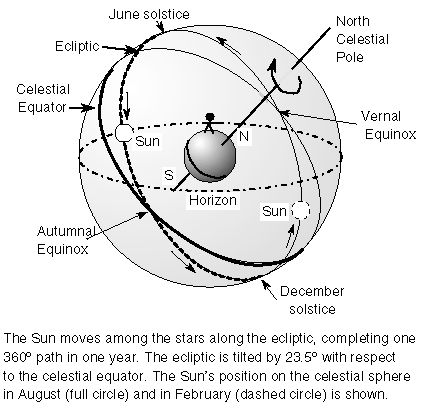
The Big Dipper is one of the easiest groupings of stars in the sky to identify, and it serves as a guide to some of the more interesting stars in other parts of the sky. Late Spring evenings it is nearly overhead as seen from San Francisco, and its distinctive pattern provides an interesting exercise for understanding the motions of objects in the heavens.
The Big Dipper is not a constellation, by strict definition, because it is only the brightest 7 stars of the larger constellation Ursa Major. A named combination of stars within a constellation such as the Big Dipper is known as an "
asterism." Because of its distinctive shape, the Big Dipper is a very well known asterism, one of several celestial groupings that lives up to its name (I put Leo, Scorpius, Cygnus and a few other constellations in this special class).
The Big Dipper points to the North Star (Polaris) if you follow the two stars at the side of the bowl of the dipper.
This Wikipedia article illustrates this nicely. The line along the pointers from the Big Dipper to Polaris is helpful because this line is similar to an hour hand on a 24-hour clock. Every 24 hours the Big Dipper makes one counter-clockwise rotation around Polaris. From latitude 38 degrees north (approximately the latitude here in San Francisco) the Big Dipper is high in the sky when it is above Polaris (as it is now at sunset) and low in the sky when it is rotated half way around Polaris just above the horizon (as it will be in late Fall evenings).
The three stars in the handle of the Big Dipper form a curve, and if you think of this curve as an arc, you can follow it to a very bright star called Arcturus (in the constellation Bootes), and by continuing along this arc you end up at another bright star called Spica (in the constellation Virgo).
One more fun thing to find in the Big Dipper is the middle star of the handle, known as Mizar (see image above). This star has a very close companion, Alcor, next to it and if you want to test your eyesight, see if you can split the two without using binoculars or a telescope.
Enjoy learning about the Big Dipper in the pleasant weather of May and June. It's full of surprises and one of my favorite stops when sharing the sky with friends and guests at star parties.
 During an Eclipse Season, the Moon's position in the sky is special, as it is moving just above or just below the plane of the planets (the "Ecliptic") in the interval from New Moon to Full Moon. A few days ago as the Moon emerged from the evening glare waxing each evening, you could see it move just below Venus, then below Regulus and Mars, and now it is below Saturn and Spica, all objects on or near the Ecliptic. As it nears Full Moon and the Lunar Eclipse on the 26th, it is moving closer and closer to the Ecliptic and will intersect the Earth's shadow on the 26th.
During an Eclipse Season, the Moon's position in the sky is special, as it is moving just above or just below the plane of the planets (the "Ecliptic") in the interval from New Moon to Full Moon. A few days ago as the Moon emerged from the evening glare waxing each evening, you could see it move just below Venus, then below Regulus and Mars, and now it is below Saturn and Spica, all objects on or near the Ecliptic. As it nears Full Moon and the Lunar Eclipse on the 26th, it is moving closer and closer to the Ecliptic and will intersect the Earth's shadow on the 26th.  I like to imagine that there is a dark spot in the sky where the Earth's shadow projects out into space. Every month as the Moon nears Full, it sweeps close to that spot. But only during an Eclipse Season -- every six or twelve months -- does it slip into the shadow of the Earth and display to all of us the curved shadow of the Earth. That is something to look forward to next weekend.
I like to imagine that there is a dark spot in the sky where the Earth's shadow projects out into space. Every month as the Moon nears Full, it sweeps close to that spot. But only during an Eclipse Season -- every six or twelve months -- does it slip into the shadow of the Earth and display to all of us the curved shadow of the Earth. That is something to look forward to next weekend.










